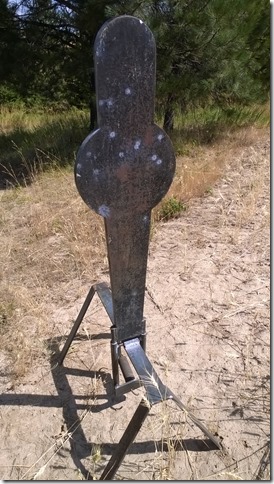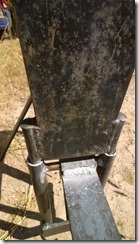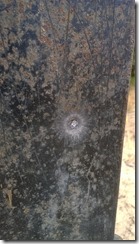Phil repaired the Boomershoot target steel someone (not a Boomershooter, it’s a long story) damaged with steel core bullets. This last weekend I tested the “target dog” he built for me. It was also the first time I had shot at the steel myself from further than about 75 yards.
Except for a single shot with a .40 S&W from about 20 yards all the shots were from 375 yards.
The target is 3/4” AR500 so they are not your standard pistol targets. They were intended to stand up to .300 Win Mag from 375 yards and beyond. The white splotches on the target above were almost all from 55 grain .223 FMJ bullets at 375 yards. They barely took the paint off and as near as I could tell did not rock the target backward. The spring, as Phil noted, is way too stiff for that. And I suspect that with a .223 and that massive of a target it’s physically impossible to select a spring such that a bullet strike would knock it backward such that a mild breeze wouldn’t also do that. The .40 S&W didn’t move the target either.
Notice the white stuff at the base of the target? That is lead spray from the bullet strikes on the target.
I was trying to zero my .300 Win Mag, without a spotter, from 375 yards and only got two hits as I probed different hold overs and unders. And the bullet splash on the steel was so small I couldn’t see it even with the 14 power scope at that distance. Here you see the impact from a 190 grain Sierra Match King bullet hitting the steel at about 2475 fps:
There is just the tiniest of craters there.
A hit on the edge of the steel is another matter:
The two .300 Win Mag hits weren’t particularly good to judge the knockdown potential of the configuration but as near as I could tell there was, again, no movement.
I’m extremely pleased with the crater repair Phil did. The targets look awesome! But we need to crunch some numbers to see if it is possible to choose a spring or maybe redesign the target dog such that it will be self resetting for a .30 caliber bullet at Boomershoot distances.





Incidentally… when is 2015 Boomershoot registration opening?
I’m still working on the software to allow credit card purchases. I was using “Google Checkout” but they discontinued that product. I’m making progress but I have a lot other things going on in my life and progress is slower than I would like. I would like to think it will be within the next three or four weeks but I just can’t promise anything.
Why not design the target as a windmill or waterwheel, that can be kept in constant motion by repeated hits?
I’m sure a stable target is more sensible, but I thought we were talking fun here.
And if the shooting line at Boomershoot couldn’t keep a kinetic target moving, who could?
I accept craters, occasional cracked welds and damage as a fact of life with target steel. We use them mostly for pistol, but I’ve had 300 WSM on a 3/8″ AR400 plate and been surprised how well it holds up. But that was a rare hit. Normally they see nothing more than .223 60 yards or so. I get to repair a steel after 2-3 years, on average, and it’s usually because the rear bracket cracks off. I bought the ones I have now, but in the future will just make my own (like you).
One thing I learned if you are doing your own: you will usually need to preheat the AR steels before you weld them. Every composition is a little different, so you’ll need to find out exactly what your “AR500” is, and get the technical data. Some have a pretty narrow pre-heat range – too low and the weld will fail, too high and the tensile and abrasion resistance gets lost. It might be worth some cheap color crayons to test before you throw sparks.
I’m about three weeks away from getting some AR plate and cutting it up for more targets. I find nothing cuts that stuff as good as plasma (except maybe water, but I’m talking in the range of machines I can reasonably afford to purchase).
I’d be curious to see what you guys did on the weld process. I learned a bit from a guy who fixes construction equipment, and the AR-type steels are commonly used for buckets and earth moving components.